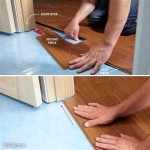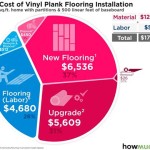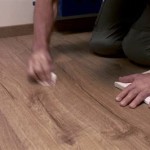Wood Flooring Laminate: A Comprehensive Overview
Wood flooring laminate, often referred to simply as laminate flooring, is a multi-layer synthetic flooring product fused together through a lamination process. It simulates the appearance of hardwood or stone flooring while offering a more cost-effective and often more durable alternative. Its accessibility and relative ease of installation have made it a popular choice for residential and commercial spaces alike. Understanding the composition, manufacturing, types, benefits, and installation nuances of wood flooring laminate is crucial for making informed decisions regarding flooring options.
The core components of laminate flooring contribute to its overall performance and aesthetic appeal. Typically, a laminate floor comprises four distinct layers: the wear layer, the décor layer, the core board, and the backing layer. Each layer serves a specific purpose, contributing to the floor's durability, appearance, and stability.
The wear layer is the uppermost surface of the laminate plank. It is a transparent, protective coating made from aluminum oxide or melamine resin. This layer is designed to resist scratches, stains, fading, and general wear and tear. The thickness and composition of the wear layer directly impact the floor's durability and suitability for areas with varying levels of foot traffic. Products with thicker wear layers are generally more resistant to abrasion and are consequently better suited for high-traffic areas like hallways and living rooms.
Beneath the wear layer lies the décor layer, a high-resolution photographic image that replicates the look of natural wood, stone, or other materials. Advanced printing technology allows for a wide range of realistic patterns and textures. This layer is a critical component in defining the aesthetic of the flooring. The quality of the image and the embossing techniques used to create texture contribute significantly to the overall realism and visual appeal of the laminate floor.
The core board, typically made of high-density fiberboard (HDF) or medium-density fiberboard (MDF), forms the structural foundation of the laminate plank. This layer provides stability, impact resistance, and resistance to moisture. HDF is generally preferred for its higher density and greater resistance to moisture absorption compared to MDF, making it a more durable option, especially in areas prone to humidity. The thickness of the core board also contributes to the floor's overall stability and its ability to withstand heavy loads.
Finally, the backing layer, also known as the balance layer, is the bottom-most layer of the laminate plank. It is designed to provide stability and protect the core board from moisture intrusion from the subfloor. This layer also helps to prevent warping and cupping. The backing layer often consists of melamine or a similar moisture-resistant material. A well-constructed backing layer is essential for ensuring the longevity and performance of the laminate floor, especially when installed in potentially damp environments.
Understanding the Manufacturing Process
The manufacturing of wood flooring laminate involves a multi-step process that combines heat, pressure, and precise engineering to create a durable and aesthetically pleasing product. The process begins with the preparation of the individual layers, followed by their assembly and bonding.
The first step involves the sourcing and preparation of the raw materials. The HDF or MDF core board is produced from wood fibers that are compressed and bonded together using resins. The décor layer is created using high-resolution digital images that are printed onto special paper. The wear layer is typically a coating applied and cured using UV light or heat. The backing layer is prepared from melamine-impregnated paper or other suitable materials.
The layers are then assembled in the correct order. The core board is placed between the décor layer and the backing layer. A pressing process then uses high heat and pressure to bond the layers together. This process involves the use of adhesives and precise control of temperature and pressure to ensure a strong and durable bond between the layers. The pressing process also imparts texture to the surface of the laminate, further enhancing its realism.
After the pressing process, the laminate sheets are cooled and then cut into individual planks or tiles. The edges of the planks are often profiled using a tongue-and-groove or click-lock system, which allows for easy and secure installation. The planks are then inspected for quality and packaged for distribution. Quality control is a critical aspect of the manufacturing process, ensuring that the finished product meets the required standards for durability, appearance, and performance.
Technological advancements have significantly impacted the laminate flooring manufacturing process. Digital printing technology allows for increasingly realistic and intricate designs. Improved pressing techniques result in stronger and more durable laminates. And innovative locking systems have simplified installation, reducing the time and skill required to install laminate flooring.
Benefits and Drawbacks of Wood Flooring Laminate
Wood flooring laminate offers several compelling advantages over other flooring options, making it a popular choice for homeowners and businesses. However, it is also important to consider the potential drawbacks before making a flooring decision.
One of the primary advantages of laminate flooring is its affordability. Compared to solid hardwood or engineered hardwood, laminate is significantly less expensive, both in terms of material costs and installation costs. This makes it an attractive option for budget-conscious consumers who want the look of wood without the high price tag.
Durability is another key benefit of laminate flooring. The wear layer protects the floor from scratches, stains, and fading, making it suitable for high-traffic areas and households with children and pets. Laminate is also resistant to impact damage, and some types of laminate are even water-resistant, making them suitable for use in kitchens and bathrooms (although standing water should still be avoided).
Ease of installation is another significant advantage. Most laminate flooring products feature a click-lock system that allows for a floating installation, meaning the planks are not glued or nailed to the subfloor. This simplifies the installation process and makes it possible for homeowners to install the flooring themselves, saving on professional installation costs. Furthermore, laminate flooring can often be installed over existing floors, provided the subfloor is level and in good condition.
Maintenance of laminate flooring is also relatively simple. Regular sweeping or vacuuming is typically sufficient to keep the floor clean. For deeper cleaning, a damp mop and a mild cleaning solution can be used. Laminate flooring is resistant to stains and spills, making it easy to clean up messes. However, it is important to avoid using excessive water, as this can damage the core board.
Despite its many advantages, laminate flooring also has some drawbacks. One potential disadvantage is its lack of authenticity. While high-quality laminate can closely resemble real wood, it is still a synthetic product and lacks the natural warmth and character of solid hardwood.
Another potential drawback is its susceptibility to moisture damage. While some laminate floors are water-resistant, they are not waterproof. Prolonged exposure to water can cause the core board to swell and warp, leading to irreparable damage. It is therefore important to avoid using laminate flooring in areas that are prone to flooding or excessive moisture.
Finally, laminate flooring can be difficult to repair. Unlike solid hardwood, which can be sanded and refinished, laminate flooring cannot be repaired if it is scratched or damaged. In most cases, the damaged plank will need to be replaced. This can be a time-consuming and potentially costly process, especially if the flooring is no longer in production.
Installation Considerations and Best Practices
Proper installation is paramount to the long-term performance and appearance of wood flooring laminate. While often touted as a DIY-friendly project, attention to detail and adherence to best practices are essential for achieving a professional and durable result.
Subfloor preparation is a critical first step. The subfloor must be clean, level, and dry. Any imperfections in the subfloor, such as cracks or unevenness, must be addressed before installing the laminate flooring. Unevenness can cause the laminate planks to flex and potentially separate over time. A self-leveling compound can be used to smooth out any irregularities in the subfloor. In addition, a moisture barrier should be installed over the subfloor to prevent moisture from seeping into the laminate flooring. This is particularly important when installing laminate over concrete subfloors.
Acclimation is another important consideration. Laminate flooring should be acclimated to the room in which it will be installed for at least 48 hours prior to installation. This allows the planks to adjust to the temperature and humidity of the room, minimizing the risk of expansion or contraction after installation. The planks should be laid flat in the room, with air circulating around them.
When installing the laminate flooring, it is important to follow the manufacturer's instructions carefully. Typically, the installation process involves clicking the planks together, starting from one wall and working your way across the room. A tapping block and a pull bar can be used to ensure a tight and secure fit between the planks. It is also important to leave an expansion gap of about ¼ inch around the perimeter of the room. This allows the flooring to expand and contract without buckling. Baseboards and quarter-round molding can be used to cover the expansion gap and provide a finished look.
When cutting the laminate planks, it is important to use the appropriate tools. A circular saw or a jigsaw can be used to cut the planks to size. A laminate flooring cutter can also be used for straight cuts. It is important to wear safety glasses and a dust mask when cutting laminate flooring.
Proper maintenance after installation will also extend the life of the laminate flooring. Regular sweeping or vacuuming will keep the floor clean. Spills should be cleaned up immediately to prevent staining or water damage. Avoid using abrasive cleaners or excessive water when cleaning the floor. A damp mop and a mild cleaning solution are typically sufficient. Do not use wax or polish on laminate flooring, as this can damage the wear layer. Using furniture pads under heavy objects will help to prevent scratches and dents.

Laminate Floor Guide Lowe S

Laminate Vs Hardwood Flooring Major Differences Forbes Home

Laminate Flooring The Home Depot

2024 Laminate Flooring Trends 10 Stylish Ideas

Laminate Wood Flooring Ideas

Knowledge What Is Laminate Wood Flooring Interio Floors

Engineered Flooring Vs Laminate Everything You Need To Know Forbes Home

Complete Guide To Laminate Flooring In With Cost And Benefits

Wood Laminates Stevenson Carpets Flooring Rotherham

Engineered Hardwood Vs Laminate Flooring What S The Difference
Related Posts








